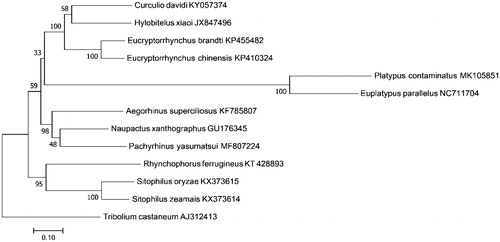Abstract
Platypus contaminatus attacked healthy hawthorn trees in China. The complete mitogenome of P. contaminatus was 15,712 bp in length. It contained 2 ribosomal RNA genes, 22 transfer RNA genes, 13 protein-coding genes and a 1038-bp long non-coding AT-rich region. This species showed rearrangements in mitochondrial genome. These changes included: (1) the reversal of the order of tRNATrp and tRNAGln genes; (2) tRNASer moved from its ancestral position (between cob and nad1) to the nad2–tRNAGln gene junction. Phylogenetic analysis using nucleotide sequences of 13 PCGs showed that P. contaminatus was closely related to Euplatypus parallelus, which was similar to the previous research.
The Platypodinae is a largely tropical and subtropical subfamily of weevils (Curculionidae) that have been nearly neglected in China. Platypodinae have more than 1400 species worldwide (Beaver and Shih Citation2003), but only about 20 species have been recorded in China. Platypodinae weevils usually attack stressed or weakened trees, but some species can attack living trees (Bumrungsri et al. Citation2008). Platypus contaminatus is one of the few species which attack healthy trees. They attacked healthy hawthorn trees and caused huge loss to Hawthorn industry in Jincheng County, Shanxi Province, China (Wang Citation1983, Citation1989; Sun and Shen Citation1991). In order to explore its phylogenetic relationship with other ambrosia beetles, we provide the complete mitochondrial genome of P. contaminatus (GenBank: MK105851). P. contaminatus individuals were collected in June 2012 at Bagong Township, Zezhou County, Shanxi Province, China, and the specimens were stored at the Invasive Alien Species Lab in Jiangxi Agricultural University with the record number of 2012VI12001, which were identified by Dr. Roger A. Beaver.
The complete mitogenome of P. contaminatus was a closed circular molecule of 15,712 bp in length. The nucleotide composition included A = 41.6%, T = 34%, C = 14.7%, G = 9.7%, and was biased toward AT (accounting for 75.6%). It contained 2 ribosomal RNA genes (rrnL and rrnS), 22 transfer RNA genes(tRNAs), 13 protein-coding genes (PCGs) and a 1038 bp long non-coding AT-rich region(A + T = 83.5%). In Coleoptera (beetles) the available mitogenome sequences suggested a uniform gene order corresponding to the ancestral holometabolan arrangement (Friedrich and Muqim Citation2003; Sheffield et al. Citation2008). However, this species showed rearrangements in the mitochondrial genome. These changes included: (1) the reversal of the order of the tRNATrp and tRNAGln genes; (2) tRNASer moved from its ancestral position (between cob and nad1) to the nad2–tRNAGln gene junction. The rrnL was 1271 bp with an AT content of 80.9%, while the rrnS was 742 bp long with an AT content of 75.9%. All of the 22 tRNAs had a characteristic clover-leaf secondary structure, except for trnS1 (AGN) which lacked a stable dihydrouridine (DHU) stem and replaced by a simple loop. And all of them ranged in the size from 62 to 71 bp. The total length of the 13 PCGs was 10,848 bp with an overall A + T content of 73.7%. The initial codons for 12 PCGs of P. contaminates were the canonical putative start codons ATN (five with ATA, three with ATG, and four with ATT). Only nad1 started with TTG. All 13 PCGs had complete stop codons (one with TAG, four with TGA, and eight with TAA).
To further explore the evolution of P. contaminates, the concatenated nucleotide sequences of 13 PCGs from 11 Curculionidae species and one outgroup species from the family Tenebrionidae (Tribolium castaneum) were used for the phylogenetic analysis. The result showed that P. contaminatus was closely related to Euplatypus parallelus (), which was similar to the previous research (Gillett et al. Citation2014).
Acknowlegements
We thank Chengpeng Long, Peng Liu, Dr Qingyun Guo (Gannan Normal University) for data processing and guide.
Disclosure statement
The authors report no conflicts of interest. The authors alone are responsible for the content and writing of this article.
Additional information
Funding
References
- Beaver RA, Shih HT. 2003. Checklist of Platypodidae (Coleoptera: Curculionoidea) from Taiwan. Plant Prot Bull. 1:75–90.
- Bumrungsri S, Beaver R, Phongpaichit S, Sittichaya W. 2008. The infestation by an exotic ambrosia beetle, Euplatypus parallelus (F.) (Coleoptera: Curculionidae: Platypodinae) of Angsana trees (Pterocarpus indicus Willd.) in southern Thailand. Songklanakarin J Sci Technol. 5:579–582.
- Friedrich M, Muqim N. 2003. Sequence and phylogenetic analysis of the complete mitochondrial genome of the flour beetle Tribolium castanaeum. Mol Phylogenet Evol. 26:502–512.
- Gillett C, Timmermans J, Emerson V. 2014. Bulk de novo mitogenome assembly from pooled total DNA elucidates the phylogeny of weevils (Coleoptera: Curculionoidea). Mol Biol Evol. 318:2223–2237.
- Sheffield NC, Song H, Cameron SL, Whiting MF. 2008. A comparative analysis of mitochondrial genomes in Coleoptera (Arthropoda: Insecta) and genome descriptions of six new beetles. Mol Biol Evol. 25:2499–2509.
- Sun D, Shen S. 1991. The population dynamics and integrated control of hawthorn trunk borer. J Plant Protec. 18:231–234. [in Chinese].
- Wang Y. 1983. A brief of two hawthorn trunk borer. Shanxi Fruits. 1:42–45. [in Chinese].
- Wang Y. 1989. Two important insect pest on hawthorn—a further report on hawthorn trunk borer and Xyleborus hubricollis Eichhoff. Chinese J Appl Entomol. 1:19–21. [in Chinese].

